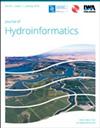Distributed Muskingum model with a Whale Optimization Algorithm for river flood routing
IF 2.2
3区 工程技术
Q3 COMPUTER SCIENCE, INTERDISCIPLINARY APPLICATIONS
引用次数: 1
Abstract
Abstract This research introduces a novel nonlinear Muskingum model for river flood routing, aiming to enhance accuracy in modeling. It integrates lateral inflows using the Whale Optimization Algorithm (WOA) and employs a distributed Muskingum model, dividing river reaches into smaller intervals for precise calculations. The primary goal is to minimize the Sum of Square Errors (SSE) between the observed and modeled outflows. Our methodology is applied to six distinct flood hydrographs, revealing its versatility and efficacy. For Lawler's and Dinavar's flood data, the single-reach Muskingum model outperforms multi-reach versions, demonstrating its effectiveness in handling lateral inflows. For Lawler's data, the single-reach model (NR = 1) yields optimal parameters of K = 0.392, x = 0.027, m = 1.511, and β = 0.010, delivering superior results. Conversely, when fitting flood data from Wilson, Wye, Linsley, and Viessman and Lewis, the multi-reach Muskingum model exhibits better overall performance. Remarkably, the model excels with the Viessman and Lewis flood data, especially with two reaches (NR = 2), achieving a 21.6% SSE improvement while employing the same parameter set. This research represents a significant advancement in flood modeling, offering heightened accuracy and adaptability in river flood routing.基于鲸鱼优化算法的河流洪水调度分布式Muskingum模型
摘要为了提高模型的准确性,提出了一种新的非线性河流洪水路径模型。它使用鲸鱼优化算法(WOA)集成横向流入,并采用分布式Muskingum模型,将河流划分为更小的间隔以进行精确计算。主要目标是最小化观测到的和模拟流出之间的平方和误差(SSE)。我们的方法应用于六个不同的洪水水文,揭示了它的多功能性和有效性。对于Lawler和Dinavar的洪水数据,单河段Muskingum模型优于多河段模型,证明了其在处理横向流入方面的有效性。对于Lawler的数据,单步模型(NR = 1)的最优参数为K = 0.392, x = 0.027, m = 1.511, β = 0.010,具有较好的效果。相反,当拟合Wilson、Wye、Linsley、Viessman和Lewis的洪水数据时,多河段Muskingum模型表现出更好的整体性能。值得注意的是,该模型在Viessman和Lewis洪水数据上表现出色,特别是在两条河段(NR = 2)时,在使用相同参数集的情况下,SSE提高了21.6%。这项研究代表了洪水建模的重大进步,提高了河流洪水路径的准确性和适应性。
本文章由计算机程序翻译,如有差异,请以英文原文为准。
求助全文
约1分钟内获得全文
求助全文
来源期刊

Journal of Hydroinformatics
工程技术-工程:土木
CiteScore
4.80
自引率
3.70%
发文量
59
审稿时长
3 months
期刊介绍:
Journal of Hydroinformatics is a peer-reviewed journal devoted to the application of information technology in the widest sense to problems of the aquatic environment. It promotes Hydroinformatics as a cross-disciplinary field of study, combining technological, human-sociological and more general environmental interests, including an ethical perspective.
 求助内容:
求助内容: 应助结果提醒方式:
应助结果提醒方式:


